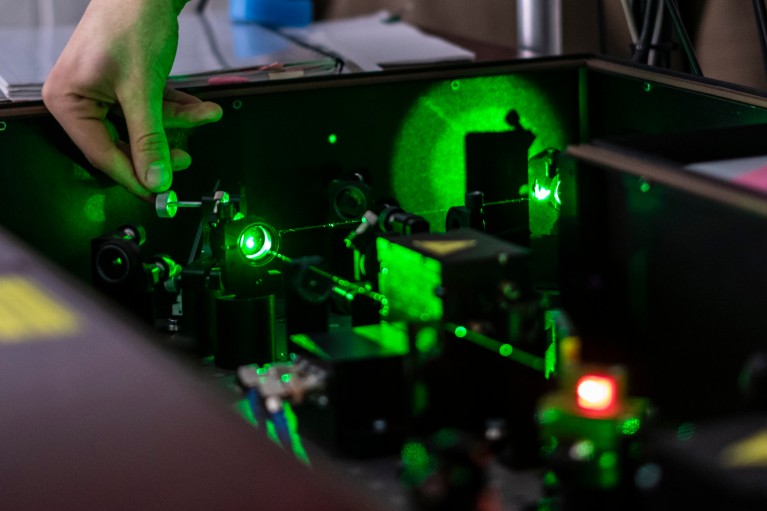
Credit: Mike_shots/Shutterstock Images.
Physicists in Italy have shown that an optical computing system, that uses photons to perform calculations, beats a digital computer at simulating the states of a spin glass, a very hard computational problem.
A spin glass can be described as a lattice of atoms each having a magnetic moment (or spin) pointing either upward or downward, which can be described by a -1 or +1 variable. Unlike ferromagnetic materials, where magnetic moments all point in the same direction, spin glasses have randomly aligned spins.
The research team was co-ordinated by Marco Leonetti from the NANOTEC Institute of the National Research Council (CNR) and the Italian Institute of Technology in Rome, and Giorgio Parisi, a physicist at Sapienza Università di Roma and CNR and current president of Accademia dei Lincei who was awarded the Boltzmann Medal in 1992 for his contributions to spin glass theory, devised an optical system which simulates spin glass and published their findings in the Proceedings of the National Academy of Sciences of the USA1.
The core component of the system is a Digital Micromirror Device (DMD) used to shape the wavefront of a laser beam. It is a one-million-pixel rectangular matrix, where each pixel is a tiny mirror 13 micrometres long. Each micromirror can be oriented along two different directions in about 18 microseconds.
“Each mirror can either block incoming light or transmit it, corresponding to a 0 or 1 variable. We grouped four micromirrors into one and manipulated their orientations so that they flip the phase of the incoming waves in order to obtain a -1 or +1 amplitude,” explains first author Marco Leonetti, a physicist at IIT and CNR in Rome.
The light rays emerging from the DMD interfere with each other and are directed to a camera which measures the light intensity on a number of target points on its lens. The total intensity depends on the phases of the incoming light rays in the same way the energy of a spin glass depends on the spin configuration.
Leonetti and co-authors then implemented an algorithm on the optical system to find the equilibrium states of a spin glass and investigate how the system approaches them. “As we take into account many target points on the camera, we observe the transition to a glassy phase below a critical temperature, which we are able to estimate,” says Luca Leuzzi, theoretical physicist at the CNR-NANOTEC Institute and one of the authors of the study.
On a digital computer, the time needed to perform a step of the algorithm grows exponentially with the number of incoming spins, whereas it remains nearly constant in the optical system. In particular, the optical system outperforms a digital system once the incoming rays exceed 12 thousand. The experiment could be modified to describe variables with more than two possible states. This could allow, for example, calculating the affinity among proteins.
“It is a genuinely original idea to build an optical system behaving like a spin glass,” says Sergio Ciliberto, an experimentalist at École Normale Supérieure de Lyon, who was not involved in the study. “Interesting applications could be image and shape recognition algorithms, but the crucial point is finding a method to encode the training data.”
